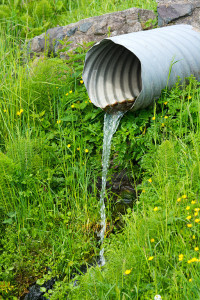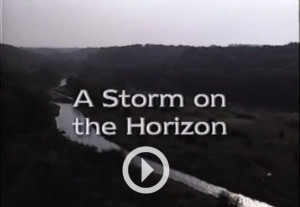Storm Water
Undeniable detriment to our cold water resources.The Impact of Storm Water on Our Cold Water Resources
The Kiap-TU-Wish chapter of Trout Unlimited is doing leading edge work in the area of storm water impacts on the coldwater resource. We invite you to read and study the resources below and jump in and help on the fight.
To prevent the loss of another beautiful midwestern trout stream to the hands of development, a temperature-monitoring project was undertaken by the Kiap-TU-Wish Chapter of Trout Unlimited. The goal of these efforts was to document the effect that stormwater runoff had on the temperature and composition of the Kinnickinnic River in River Falls. We had also begun monitoring the Willow River near Hudson, and the Trimbelle River near Beldenville.
 Overview:
Overview:
Urbanized areas pose special threats to water quality. Urbanization disrupts the natural course of water as it moves across a watershed. Removing vegetation and constructing impervious surfaces such as roads, parking lots, driveways, sidewalks, and rooftops greatly increases the amount and rate of storm water runoff. Water level fluctuations increase because of lower stream base flow from reduced infiltration and increased storm water flow from impervious surfaces.
These changes may bring flooding, increased water temperatures, decreased oxygen levels, greater channel erosion, and increased sedimentation. As storm water runoff crosses the urbanized landscape; it picks up fertilizers, pesticides, debris, salt, oil, grease, other toxic substances, and sediments leading to decreased water quality.
The impacts of storm water runoff include: thermal pollution, the increased transportation of sediment and pollutants, and increased stream flow, both volume and velocity.
The concern about development having negative impacts on local trout streams is not unfounded. The Twin Cities area once boasted numerous trout streams, most of which have now been totally lost or degraded beyond reclamation.
Indirectly Affected by Their Food Source
While trout may be able to survive certain fluctuations in temperature, the food they rely on, mainly aquatic insects, may not. A Maryland study determined that many coldwater insect species would be eliminated or reduced by the thermal enrichment of a stream. Important species to the trout, such as stoneflies, mayflies, and caddisflies, would be severely impacted or stressed by stream temperature fluctuations. Thus stream temperature fluctuations have not only the potential to stress the trout directly, but indirectly through their food source as well.
The Kinnickinnic. A River at a Crossroad.
Some of the best trout fishing in the Midwest can be found in St. Croix County, one of the fastest-growing counties in Wisconsin. The City of River Falls, located on the southern edge of St. Croix County and in the heart of the Kinnickinnic River Watershed is home to 12,000 people. Because of its close proximity to the major metropolitan area of Minneapolis-St. Paul, MN, River Falls is a rapidly growing community, with a 20% population increase during the past decade. Growth estimates project a population of 16,500 by the year 2010. This estimate may be conservative, however, since it does not include growth in the surrounding townships, where agricultural lands are rapidly being converted to rural residential uses.
The Kinnickinnic River, a state “outstanding resource water,” flows through River Falls in west-central Wisconsin. A premiere trout stream, the “Kinni” is renowned for its dense populations of wild brown trout. Approximately 2,000-8,000 trout per mile reside in the river, with no stocking needed to sustain this naturally reproducing fishery. According to fisheries biologists, a trout population of 1,000 fish per mile is considered excellent.
Scientific Assessment of Local Storm Water Impacts:
The Kinnickinnic River is a valuable cold-water resource representing a major natural amenity of the River Falls community. Although trout populations in the river are currently high, the effect of growth in the City of River Falls and surrounding townships has the potential to degrade the physical, chemical, and biological characteristics of the Kinnickinnic River and its tributaries.
As growth occurs, the creation of impervious surfaces like roofs, sidewalks, driveways, streets, and parking lots generates a substantial amount of storm water runoff that can significantly affect a river. Storm water impacts include: higher stream flows, thermal pollution, chemical pollution, and sedimentation, all of which pose threats to aquatic habitat, trout, and other cold-water organisms.
Biological and Habitat Impacts:
In the early 1990s, Kiap-TU-Wish and the Wisconsin Department of Natural Resources (WDNR) began noting differences in trout populations and habitat quality in the Kinnickinnic River, above and below the City of River Falls. Likely due to storm water runoff, trout populations were significantly lower and stream bank erosion was increasing downstream from River Falls. Thermal impacts were also suspected.
Thermal Impacts:
In response to the concern about thermal pollution, Kiap-TU-Wish established a temperature monitoring network in 1992, at four locations on the Kinnickinnic River and two locations on major tributaries. With funding provided by Kiap-TUWish and the Wisconsin Council of Trout Unlimited, data-logging thermometers were purchased and installed at river locations upstream and downstream from City of River Falls storm water discharges and two local hydropower dams. The data logging thermometers record river temperatures at 10-minute intervals during the April-September period, thereby documenting any thermal impacts associated with storm water runoff during summer rains.
Significant thermal impacts have been apparent downstream from River Falls storm water discharges and hydropower dams. Rapid increases in river temperature (up to 10 degrees Fahrenheit) are frequently evident at locations downstream from storm water discharges during summer rainfalls and storm water temperatures may exceed 78 degrees Fahrenheit, the upper lethal limit for brown trout.
The thermal impact of the two city hydropower dams produces downstream temperatures that are at least 3-6 degrees Fahrenheit warmer than upstream temperatures during the summer months. Conversely, downstream temperatures are significantly cooler during the winter months, with possible impacts on incubating eggs in the trout redds.
Sediment and Nutrient Impacts:
To evaluate the possible impacts of sediment and other urban pollutants in River Falls storm water runoff, storm event-based composite sampling of residential, commercial, and industrial areas of River Falls was conducted in 1992 by Short Elliott Hendrickson (SEH), a local water resources management firm.
Support Storm Water Planning and Management Efforts:
One of the goals of the Kiap-TU-Wish temperature monitoring project was to obtain sound scientific information on the local impacts of storm water runoff. Using this monitoring information, Kiap-TU-Wish initiated a discussion with River Falls planners and policy-makers about the need for storm water management tools that would enable the city to grow while protecting the Kinni.
Local Environmental Education is Important:
In 1998, recognizing the need for an educational tool that can be used to protect coldwater resources in urbanizing areas, Kiap-TU-Wish, in partnership with Palisade Productions of Minneapolis, MN, produced a video entitled: “A Storm on the Horizon”
Using the Kinnickinnic River as the backdrop, this 15-minute video describes the value of a cold-water resource, discusses the potential threats posed to cold-water resources by urban growth, and also describes some tools available to communities for protecting these resources while accommodating growth. The video won a Silver Screen Award in the “Environmental Issues and Concerns” category at the Chicago International Film Festival in 1999.
Kiap-TU-Wish members have distributed nearly 3,000 copies of the video nationwide, to local planners and policy-makers, engineers, scientists, elementary, middle school, high school, and college educators and students, nonprofit organizations, and other Trout Unlimited members and chapters.
The Kinni is designated an “Outstanding Resource Water” by the Wisconsin Legislature – the highest classification possible.
The implications of the findings for aquatic life, specifically trout and the insects they eat, in the Kinnickinnic watershed are similar to those found in the Maryland study. As stream temperatures increase beyond the preferred range for trout, the stress on the fish will increase accordingly. Temperature spikes upwards of ten degrees, like those witnessed in a typical storm event at the Cedar Street monitoring station, coupled with increased average baseline temperatures could easily push stream temperatures towards the upper lethal limit of 77º F for trout. These temperature spikes could also have detrimental effects on resident insect populations as well.
Temperature fluctuations in the Kinnickinnic’s temperature could potentially reduce or eliminate certain temperature sensitive insect species such as the stoneflies, caddisflies, and mayflies. Given that these insects are a main staple of a trout’s diet, their elimination would mean severe consequences for the trout of the Kinnickinnic. The result of these effects could ultimately mean reduction or even destruction of the Kinnickinnic’s trout population.
Successful Steps Taken
The Kiap-TU-Wish’s stormwater monitoring project has been a great success. Designed to assess the impacts of urban stormwater runoff on the Kinnickinnic River, the project’s stream temperature monitoring and stormwater quality assessment resulted in a clear picture of these consequences. Temperature spikes during storm events and median concentrations of suspend solids above those recommended by the NURP suggested that the urban development had already begun to affect the watershed. Although the River’s trout populations were strong, the potential existed for the degradation of stream quality with severe implications for aquatic life. Once the extent of the impacts of development on the Kinnickinnic watershed was known, steps could be taken to ensure protection of the River and its trout.
Through the Wisconsin DNR Priority Watershed Program and the Kinnickinnic River Water Management Plan, the growth of River Falls and development of the land in the River’s watershed will be monitored and controlled. The end result should be the preservation of water quality and aquatic life in the Kinnickinnic River.
Committed to Conservation
Thanks to the efforts of Kiap-TU-Wish, their partners, and commitment to conservation, the Kinnickinnic watershed may not fall victim to urbanization like so many of its neighboring counterparts. Its currently healthy population of brown trout should sustain itself and the Kinnickinnic will retain its reputation as a first-rate trout stream.
As long as guidelines for development are considered and water quality is protected, the pristine waters of the Kinnickinnic River will be available for all to enjoy.


